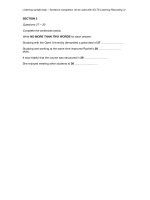Sentence synthesis
Bạn đang xem bản rút gọn của tài liệu. Xem và tải ngay bản đầy đủ của tài liệu tại đây (13.91 KB, 1 trang )
Sentence synthesis
Combination of two or more simple sentences into a single compound sentence
Two or more simple sentences can be combined to form a single compound sentence by the use of coordinating
conjunctions.
These are of four kinds – cumulative, adversative, alternative and illative
By using cumulative conjunctions
These conjunctions merely add one statement to another. Examples are: and, both…and, not only…but also, as
well as
She is smart. She is intelligent.
These two simple sentences can be combined into a compound sentence.
She is smart and intelligent.
She is both smart and intelligent.
She is smart as well as intelligent.
She is not only smart but also intelligent.
More examples are given below.
The wind blew. The rain fell.
The wind blew and the rain fell.
By using adversative conjunctions
Conjunctions which express opposition or contrast between two statements are called adversative conjunctions.
Examples are: still, yet, however, nevertheless
He is slow. He is sure.
He is slow but he is sure.
He is slow yet he is sure.
He is slow, however, he is sure.
He is slow, nevertheless, he is sure.
He failed. He didn’t lose hope.
He failed but he didn’t lose hope.
He failed yet he didn’t lose hope.
He failed; however, he didn’t lose hope.
He failed, nevertheless he didn’t lose hope.
Stay on top of your writing! Download our grammar guide from www.englishgrammar.org to stay up-to-date.
Powered by TCPDF (www.tcpdf.org)









